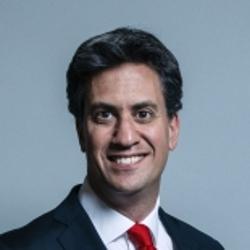
Ed Miliband
Labour - Doncaster North
9,126 (29.4%) majority - 2024 General ElectionFirst elected: 5th May 2005
Secretary of State for Energy Security and Net Zero
(since July 2024)1 Former APPG Officer Position
Sustainable FinanceDivision Voting information
Debates during the 2024 Parliament
Speeches made during Parliamentary debates are recorded in Hansard. For ease of browsing we have grouped debates into individual, departmental and legislative categories.
Department Debates
(617 debate contributions)
Legislation Debates
(3,649 words contributed)
Doncaster North Petitions
e-Petitions are administered by Parliament and allow members of the public to express support for a particular issue.
If an e-petition reaches 10,000 signatures the Government will issue a written response.
If an e-petition reaches 100,000 signatures the petition becomes eligible for a Parliamentary debate (usually Monday 4.30pm in Westminster Hall).
of 680,378 signatures (0.24%)
of 136,504 signatures (0.22%)
of 260,604 signatures (0.22%)
of 115,478 signatures (0.22%)
of 115,166 signatures (0.20%)
of 680,378 signatures (0.24%)
of 260,604 signatures (0.22%)
of 191,362 signatures (0.19%)
of 136,504 signatures (0.22%)
Latest EDMs signed by Ed Miliband
Max Freedman's service to parliamentary staff
Tabled by: Lord Cryer (Labour - Leyton and Wanstead)That this House recognises Max Freedman's commitment over 10 years as the chair of the Parliamentary staff UNITE trade union branch representing staff of all parties in Parliament and constituency offices; appreciates that over the past decade he has worked tirelessly in representing staff of hon. Members both in individual …
(Most recent: 23 Sep 2020)
Signatures by party:
Labour: 53
Independent: 9
Scottish National Party: 7
Conservative: 3
Liberal Democrat: 2
Plaid Cymru: 1
Democratic Unionist Party: 1
Green Party: 1
PROVIDING FINANCIAL RESTITUTION TO 1950s WOMEN
Tabled by: Anna McMorrin (Labour - Cardiff North)That this House welcomes the positive interventions from many hon. Members from across the House on behalf of women born in the 1950s who have lost their pensions; welcomes the equalisation of retirement ages between women and men; recalls that women born in the 1950s were subject to discriminatory employment …
(Most recent: 8 Oct 2019)
Signatures by party:
Labour: 131
Conservative: 24
Scottish National Party: 22
Independent: 15
Liberal Democrat: 15
Democratic Unionist Party: 9
Plaid Cymru: 3
Non-affiliated: 3
Crossbench: 2
The Independent Group for Change: 2
Green Party: 1
Commons initiatives
These initiatives were driven by Ed Miliband, and are more likely to reflect personal policy preferences.
MPs who are act as Ministers or Shadow Ministers are generally restricted from performing Commons initiatives other than Urgent Questions.
Ed Miliband has not been granted any Urgent Questions
Ed Miliband has not been granted any Adjournment Debates
1 Bill introduced by Ed Miliband
A Bill to make provision about Great British Energy.
This Bill received Royal Assent on 15th May 2025 and was enacted into law.
2 Bills co-sponsored by Ed Miliband
Fur Trade (Prohibition) Bill 2019-21
Sponsor - Taiwo Owatemi (Lab)
Climate Change (Emissions Targets) Bill 2017-19
Sponsor - Rachel Reeves (Lab)